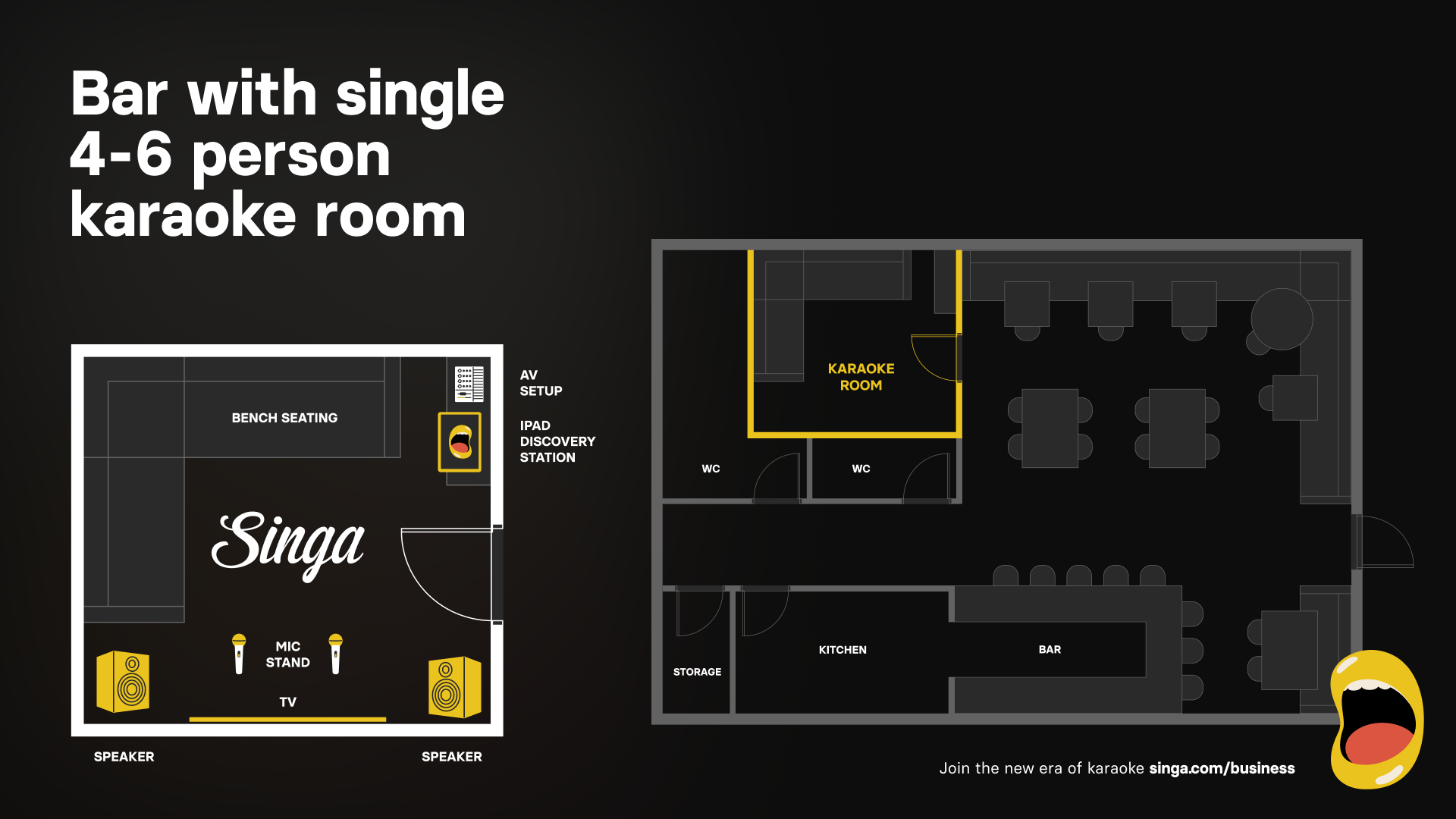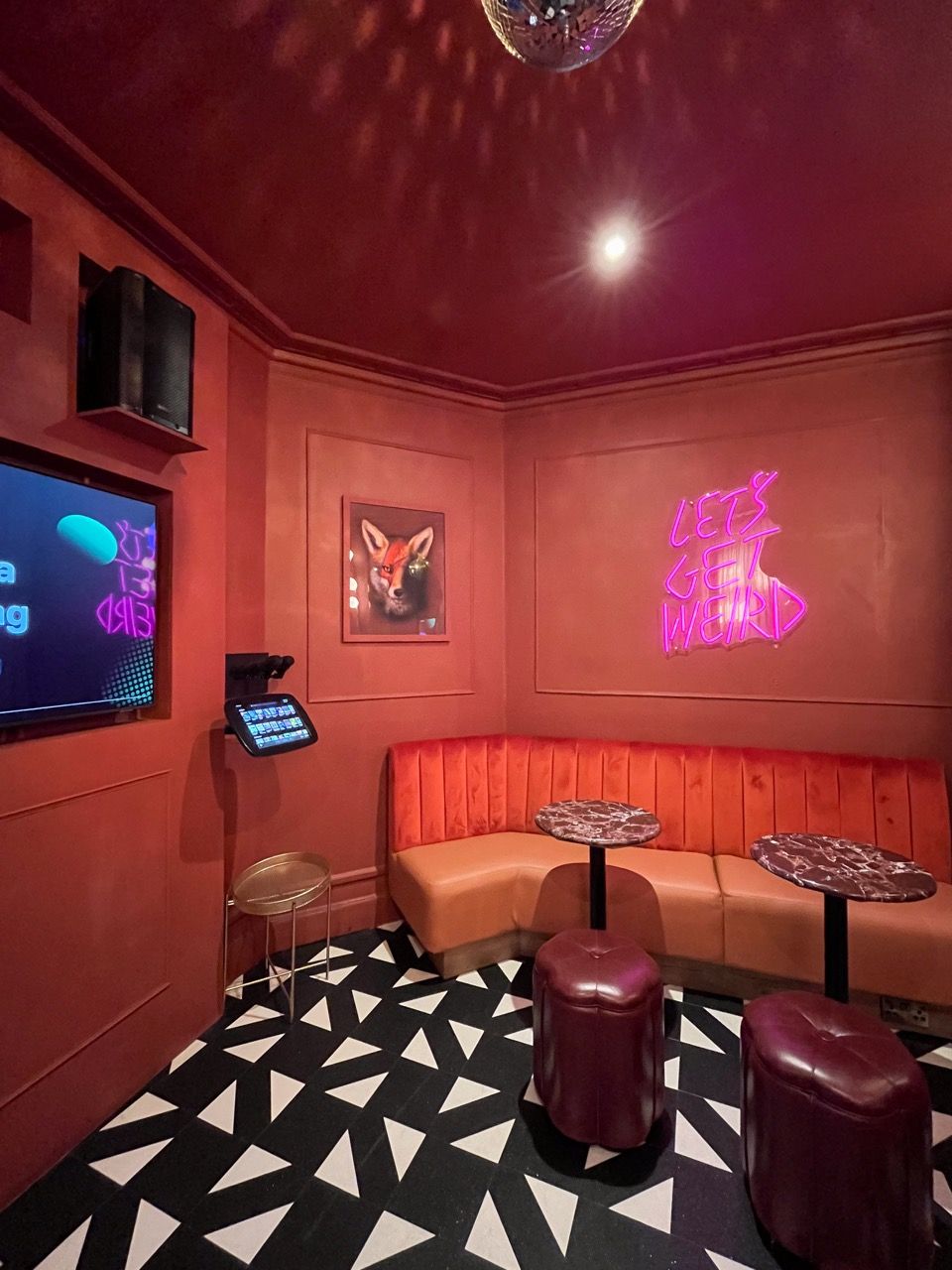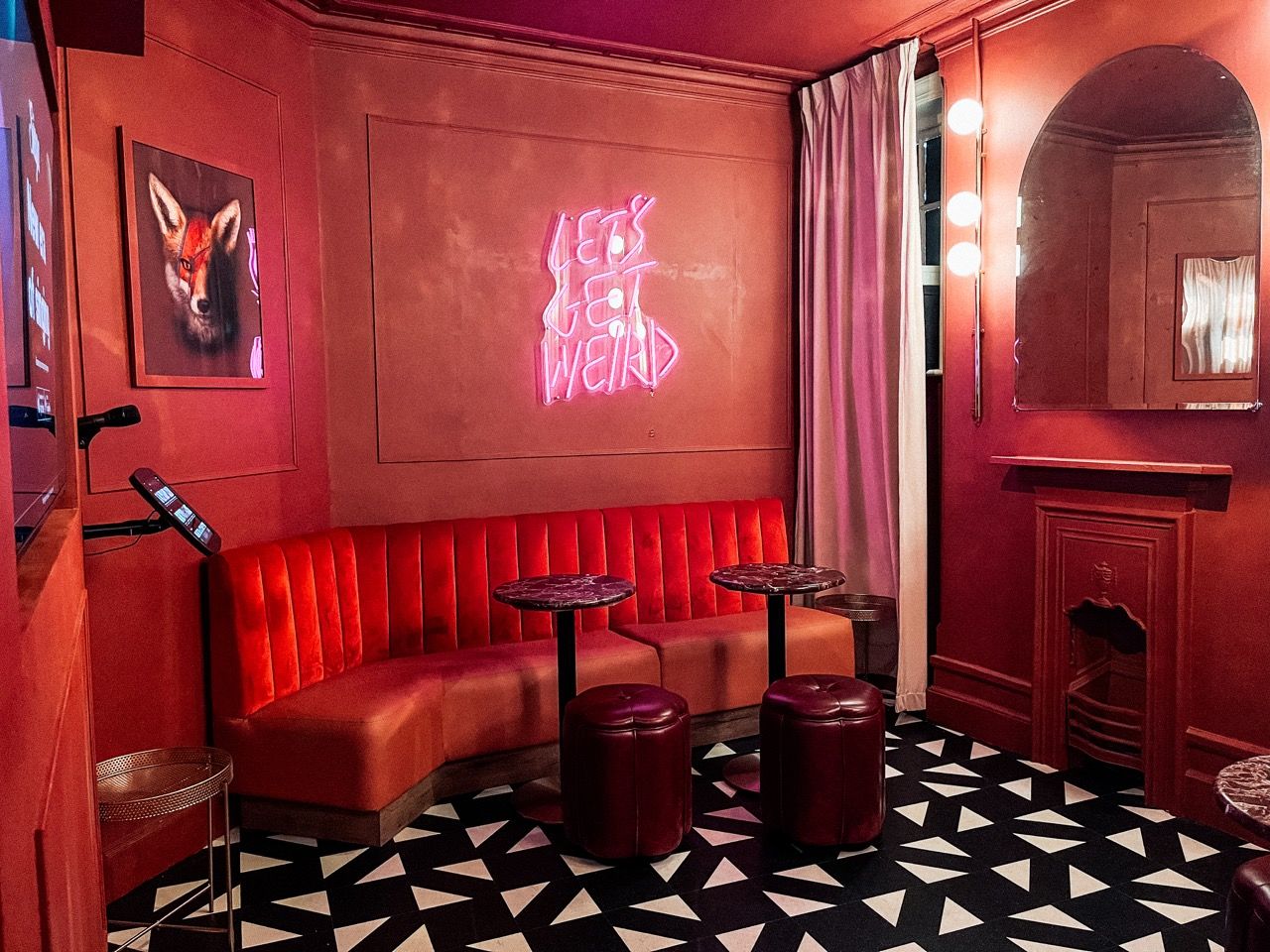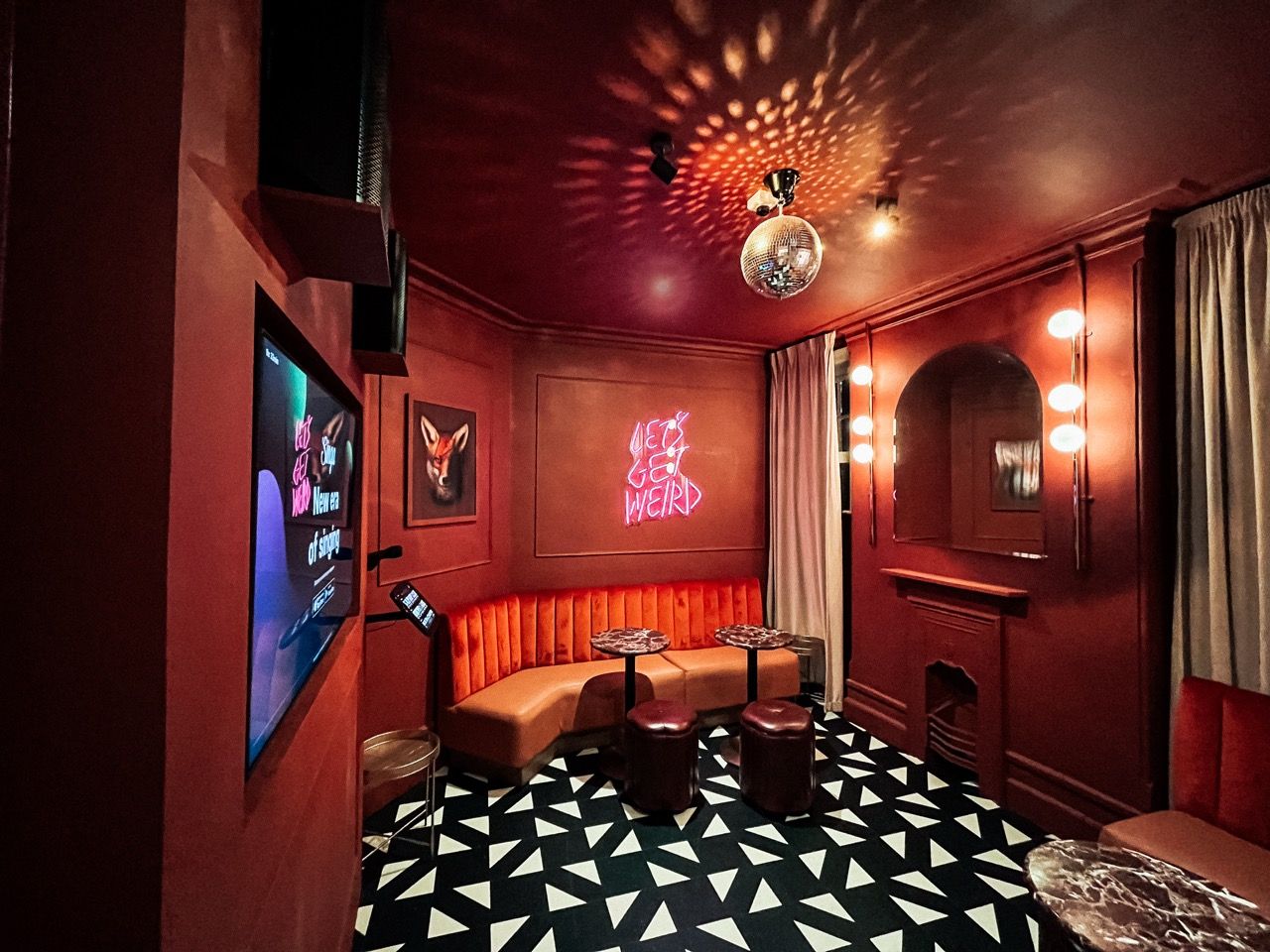Karaoke rooms are more than just singing, they are a great way to create memorable experiences for your guests. For hospitality and karaoke business owners, a well-designed karaoke room isn’t just a nice-to-have; it’s a business essential. From impeccable sound quality to Instagram-worthy aesthetics, the right setup can elevate your space, keep customers coming back, and generate revenue for your business.
In this comprehensive karaoke room design guide, we’ll walk you through everything you need to know about karaoke room design. Whether you’re starting from scratch or upgrading an existing setup, we’ll share practical tips, creative ideas, and insights to help you create a space that stands out and keeps customers coming back. This guide covers:
- Sound and Acoustic
- Lighting
- Seating and Comfort
- AV Setup
- Space and Layout
- Decor and Ambiance
- Working with Design and AV professionals
- Design Budget Planning
- Maitenance and Upkeep
- Downloadable Design and Concept Guide
- Casestudies and Gallery
1. Sound and Acoustic Design
Acoustic Design
Good acoustics make or break the karaoke experience. Without proper sound management, even the best singers can sound off-key. Focus on:
- Echo Reduction: Reduce echo by incorporating carpets, rugs, and upholstered furniture. Bare walls and floors amplify sound in unwanted ways, while soft surfaces absorb excess noise.
- Rugs and Carpets: These help reduce echos by absorbing vibrations.
- Acoustic Panels: For professional-level acoustics, install panels that absorb sound waves and prevent reverberations. These are available in a variety of colors and styles to match your decor.
- Sound Difusers: Adding sound difusers to the ceiling can help spread sound around the room.
- Adding a small stage: If you have a larger room. Elevating performers and positioning them strategically can improve sound projection and also make singers feel like they are giving their own concerts.

Soundproofing
Ensure your room contains noise within its walls to avoid disturbing other guests or neighbors. Use materials like acoustic foam, soundproof curtains, or even specialized drywall designed to block sound.
- Heavy Curtains: Use these over windows or even as wall coverings for additional sound insulation
- Soundproof doors: Most interior doors have significant gaps around the frame and are not made from soundproof materials. Installing acoustic doors is crucial to prevent noise from escaping the bar.
- Seal gaps in doors and windows with weatherstripping or door sweeps.
- Soundproof Walls: Install walls with built in acoustic blocking matertials, or add a second layer of drywall with soundproofing materials sandwiched in between.
- Install shelves along walls as an extra barrier against noise. These can also serve eaditional ergonomic use to give guest a place to store jackets and bags.
Want more soundproofing ideas and case studies? Read our guide on soundproofing your karaoke room here.

2. Lighting
Good lighting works wonders in karaoke rooms. A dark little corner can be transformed into an exciting space with ambient lights, spots, and other luminous elements. The right kind of lighting makes the room more sharable on social media as well.Consider:
- Mood Lighting: LED strips can be programmed for different colors and effects to match the energy of a song.
- Spotlights or Disco Lights: These add an element of fun and excitement, especially for performance-oriented guests.
- Dimmable Lights: Offer adjustable brightness to suit different preferences, from high-energy party vibes to mellow ballads.

3. Seating and Comfort
Seating and furniture
Comfortable seating, where everyone can easily see the karaoke sceen and move about the room is critical for the costumer experience. Consider these tips:
- Booth Seating: Installing booth seating along the wall can be a great way to maximize space, and also reduce cleaning under couches or other furniture.
- Layout: Arrange seating to provide clear sight-lines to the screen and stage. Corner sofas or modular furniture work well in smaller spaces. Also try to keep furniture close to the wall to allow room for standing and dancing.
- Spill proof: Be aware that drinks and food are likely to be spilled at some point, so choose durable and easy to clean fabrics.
- Table Placement: Try and keep tables for drinks and food along the wall and out of the center. This is especially true if you will use wired microphones.

Ventilation
Proper ventilation in a karaoke room is essential for maintaining air quality, ensuring comfort, and preventing the buildup of heat and humidity. With multiple people singing and moving around in an enclosed space, fresh air circulation is critical.
- Opt for soundproofed air vents or duct silencers to minimize unwanted disruptions.
- Regulate temperature and humidity levels to keep the room cool and prevent condensation, which can affect both equipment and acoustics.
- Clean air filters and inspect the airflow regularly to help maintain a comfortable and hygienic environment for guests.

4. AV Setup
Invest in reliable, high-quality equipment for a seamless experience. You should also consider how the equipments fits into the design as well as how you would like your singers to interact in the room.

- Screens: A TV, projector screen, or monitor. Consider multiple screens if you have a larger room soo people can see the lyrics from anywhere in the room.
- Speakers: Quality speakers are important, a decently prices, yet powerful, system like the LD Maui series can be a great choice for mid-range rooms. Consider wall-mounted or ceiling integrated speakers to keep them safe from any spillage.
- Microphones: Quality microphones are critical for the guest experience. Choosing between wired and wireless microphones depends on your room’s layout, size, and use. Both work well, but knowing their strengths and limits ensures a smart choice. Read our microphone descision guide here.
- Mixer: It is best to keep mixers hidden from guests, using digital mixers or storing them safe area can prevent errors in the sound quality.
- Cables/adaptors: Try to keep cables out of reach of clients to prevent disruptions and damage.
- iPad or Tablet: Choose larger tablets to make the song selection experience easy for guests. Consider securing them on adjustable mounts so people of varying heights can comfortably browse songs.
- A commercial karaoke program: Singa Box Mode is the go-to professional karaoke room software. With its co-branding features you can also match the interface and background images to suit your venue.
Read our full equipment guide for a karaoke set-up here.
Tech Integration and Smart Features
Modern karaoke rooms benefit greatly from smart technology. Here are some ideas:
- Digital mixers: Rather than having analog mixers in each room you can consider having a digital mixer to maintain multiple rooms.
- Volume controls: Consider have volume controls accesible to customers to adjust the audio to their needs.
- AI Sound Control: AI sound controls like Waved can be a way to control the sound outputs in the venue without staff involvement.
- Smart Lighting: Sync lighting effects with music beats to enhance the party atmosphere.
Sing Sing Karaoke uses sound activated lighting and a digital mixer in their karaoke rooms.
5. Space Considerations
Whether you are looking at a small karaoke room design, several rooms, or open stage karaoke at the heart of your venue, the space requirements depend on your floor plan and goals. Different sized rooms and layouts will influence the design of your rooms and lend themselves to certain setups over others.

Small Rooms - 1 to 10 singers
- Wall-Mounted Tech: Save valuable floor space by mounting screens, speakers, and other equipment on walls.
- Corner Seating: Maximize utility and comfort with corner arrangements and booth seating.
- Eye-Level Screens: Position screens at a comfortable height for easy lyric visibility.
Medium Rooms - 10 to 30 singers
- Stage Area: Incorporate a small stage for performances to elevate the experience.
- Seating Mix: Combine sofas and bar stools to accommodate groups of varying sizes.
- Balanced Sound: Place speakers in the corners for optimal sound distribution.
Large Rooms 30+ singers
- Activity Zones: Divide the room into separate areas for singing, dancing, and lounging.
- Multiple Screens: Ensure clear visibility of lyrics by installing several screens throughout the room.
- Central Stage: Consider having a stage area or platform for performers.
6. Decor and Ambience
Decorations
- Selfie Mirrors: Having a mirror in the room can make the space seem larger, but also give customers a place to take selfies and videos to encourage social sharing.
- Neon Signs: These can be great ways to represent your brand in the room or create additional opportunities for photos.
- Music Instruments: They can add to the design and make the room more interactive.
- Window or Glass Door: The glass element makes the room feel more open and allows other customers to sneak-peak into all the fun going on inside.
Thematic Ideas for Karaoke Rooms
Typically each karaoke room has its theme. Some karaoke customers report having an alter ego that boosts their daring to sing. The alter ego can often be activated when stepping into an environment with an encouraging theme, so feel free to blow your customers’ minds. Here are some ideas:
- Retro: Decorate with vinyl records, vintage microphones, and bright, bold colors.
- Modern Chic: Emphasize clean lines, minimalist furniture, and monochromatic palettes with pops of metallic accents.
- Neon Club: Use neon lights, LED strips, and vibrant colors for a high-energy vibe.
- Movie-Themed: Create a Hollywood-inspired space with movie posters, red carpets, and themed seating.
- Cultural Themes: Incorporate elements from specific cultures, such as Japanese-style karaoke booths with tatami mats and sliding doors.
Singa Tip: You can use Singa's co-branding tool to better reflect your theme and brand in the karaoke player and song backgrounds.
7. Working with AV and Design Professionals
Karaoke room designs can be anything from simple chic rooms to cartoonish purgatory (like at Lost Souls Karaoke). The main thing is to emphasize your venue’s vibe. It’s about branding, so consider hiring a professional interior designer to create your unique look and feel.

When it comes to designing and installing your karaoke room you need expert help to bring your vision to life. Singa can help connect you with AV installers:
- Local AV Partners: Singa works with trusted partners like TVC in the UK for professional AV installations.
- Global AV Consultants: For scalable projects, connect with experts like Effektgruppen for world-class solutions.
Check out our full list of partners and AV integrators here.
8. Budget Planning
Budgeting ensures you stay on track financially while creating a quality experience.
Use our karaoke calculator here to get an estimate and breakdown of potential costs based on your needs:

9. Maintenance and Upkeep
Proper maintenance extends the life of your equipment and keeps your room looking fresh:
- Redesigns: Consider updating room themes and designs from time to time to keep things fresh for returning customers.
- Equipment Cleaning: Regularly clean microphones, screens, and speakers.
- Furniture Repairs: Address wear and tear promptly to maintain comfort and aesthetics.
- Software Updates: Keep your karaoke systems updated for access to new songs and features.
10. Karaoke Room Design and Concept Guide
If you are looking for a concrete example of a karaoke room venue design; including tech-setup, floor plan, and design inspiration download our Karaoke Room Design and Concept Guide.
The Karaoke Room Concept & Design Guide Includes:
- Karaoke venue and room size floor plan
- Room theme and design inspiration
- Karaoke room AV set-up guide
- Example equipment and software lists
- Additional karaoke room resources

11. Karaoke Room Design Case Studies and Gallery
What creates desirability towards your karaoke room and acts as a selling point is figuring out why your venue is exceptional. Define what makes your brand yours and highlight it in your design solutions. Singa has supported several venues in their karaoke room design journey by providing the software. Take a look at this selection of rocking karaoke rooms – and prepare to get new ideas!
The Fox
A bold blend of retro flair and modern glam, this vibrant karaoke corner layers deep red walls with rich textures and quirky details. A plush velvet banquette wraps the space beneath a cheeky “Let’s Get Weird” neon sign, while wine-toned poufs and marble-topped tables ground the palette. With a fox portrait, patterned floors, and a shimmering disco ball overhead, it’s a moody-meets-playful setup made for unforgettable nights.



S2 Mall
The Melody Club
The Melody Club in Gothenburg, Sweden turns karaoke into a private stage show. They allow singers to change the background of their performance as well as have adaptable stage lighting that changes with each song. Beyond that they offer instruments and costumes and guests to further enhance the vibe.


Lane7
Nothing glows like Lane7’s UV and neon lights. They have premium dining, ten-pin bowling, ping-pong, pool, and most importantly, dazzling karaoke rooms.


Sing Sing
Vietnamese bistro Sing Sing has seven delicious karaoke rooms in various colors, shapes, and sizes. You can choose a room, for example, based on your mood.


O’Learys
Over ten O'Learys sports bars and restaurants carry a full Singa entertainment setup combined with a zappy atmosphere.


Amber Taverns
Amber Taverns is a group with over 140 pubs in the UK. The Northern Way pub in Bolton is an example of transforming an unused space into a successful karaoke room.

Holiday Bar
Holiday Bar has combined karaoke with fine dining. Their fun singalong concept brings friends and coworkers together for two of the best: savoring and karaoke.


Bloomsbury Lanes
Bowling, private karaoke rooms, and fine American food – nice combo! Bloomsbury's karaoke rooms offer a vibrant atmosphere for celebrations or pre/post bowling fun.



That sums up our top 6 factors in karaoke room design. We hope you got inspired by these concepts. For more interesting karaoke room examples, go to https://singa.com/business/case-studies.

